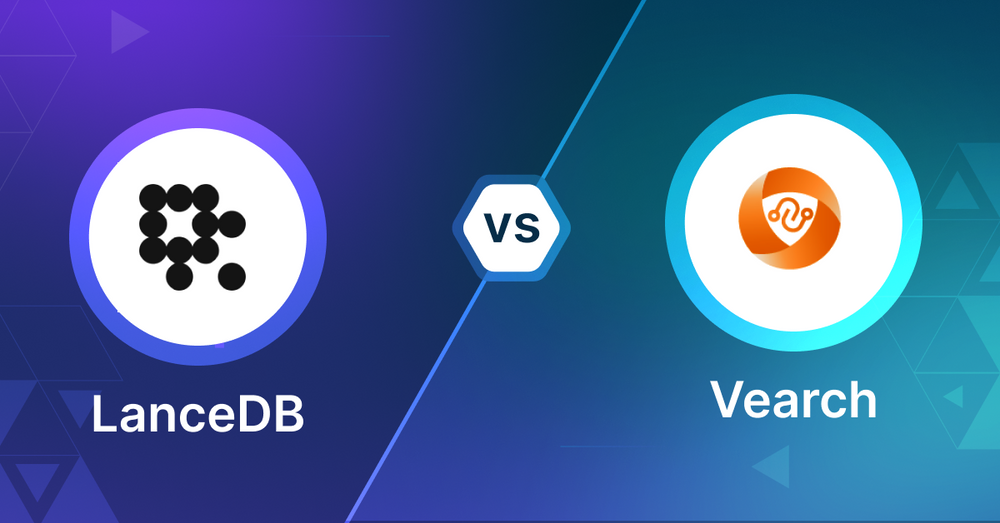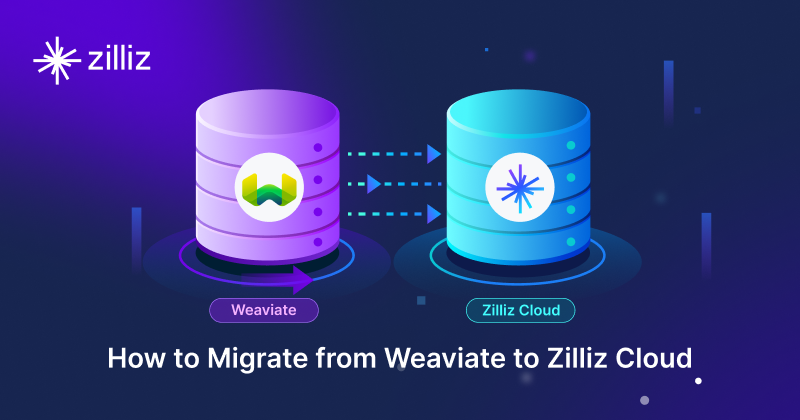LanceDB vs Vearch Choosing the Right Vector Database for Your AI Apps

What is a Vector Database?
Before we compare LanceDB and Vearch, let's first explore the concept of vector databases.
A vector database is specifically designed to store and query high-dimensional vectors, which are numerical representations of unstructured data. These vectors encode complex information, such as the semantic meaning of text, the visual features of images, or product attributes. By enabling efficient similarity searches, vector databases play a pivotal role in AI applications, allowing for more advanced data analysis and retrieval.
Common use cases for vector databases include e-commerce product recommendations, content discovery platforms, anomaly detection in cybersecurity, medical image analysis, and natural language processing (NLP) tasks. They also play a crucial role in Retrieval Augmented Generation (RAG), a technique that enhances the performance of large language models (LLMs) by providing external knowledge to reduce issues like AI hallucinations.
There are many types of vector databases available in the market, including:
- Purpose-built vector databases such as Milvus, Zilliz Cloud (fully managed Milvus)
- Vector search libraries such as Faiss and Annoy.
- Lightweight vector databases such as Chroma and Milvus Lite.
- Traditional databases with vector search add-ons capable of performing small-scale vector searches.
LanceDB is a serverless vector database and Vearch is a vector database. This post compares their vector search capabilities.
LanceDB: Overview and Core Technology
LanceDB is an open-source vector database for AI that stores, manages, queries and retrieves embeddings from large-scale multi-modal data. Built on Lance, an open-source columnar data format, LanceDB has easy integration, scalability and cost effectiveness. It can run embedded in existing backends, directly in client applications or as a remote serverless database so it’s versatile for many use cases.
Vector search is at the heart of LanceDB. It supports both exhaustive k-nearest neighbors (kNN) search and approximate nearest neighbor (ANN) search using an IVF_PQ index. This index divides the dataset into partitions and applies product quantization for efficient vector compression. LanceDB also has full-text search and scalar indices to boost search performance across different data types.
LanceDB supports various distance metrics for vector similarity, including Euclidean distance, cosine similarity and dot product. The database allows hybrid search combining semantic and keyword-based approaches and filtering on metadata fields. This enables developers to build complex search and recommendation systems.
The primary audience for LanceDB are developers and engineers working on AI applications, recommendation systems or search engines. Its Rust-based core and support for multiple programming languages makes it accessible to a wide range of technical users. LanceDB’s focus on ease of use, scalability and performance makes it a great tool for those dealing with large scale vector data and looking for efficient similarity search solutions.
What is Vearch? Overview and Core Technology
Vearch is a tool for developers building AI applications that need fast and efficient similarity searches. It’s like a supercharged database, but instead of storing regular data, it’s built to handle those tricky vector embeddings that power a lot of modern AI tech.
One of the coolest things about Vearch is its hybrid search. You can search by vectors (think finding similar images or text) and also filter by regular data like numbers or text. So you can do complex searches like “find products like this one, but only in the electronics category and under $500”. It’s fast too - we’re talking searching on a corpus of millions of vectors in milliseconds.
Vearch is designed to grow with your needs. It uses a cluster setup, like a team of computers working together. You have different types of nodes (master, router and partition server) that handle different jobs, from managing metadata to storing and computing data. This allows Vearch to scale out and be reliable as your data grows. You can add more machines to handle more data or traffic without breaking a sweat.
For developers, Vearch has some nice features that make life easier. You can add data to your index in real-time so your search results are always up-to-date. It supports multiple vector fields in a single document which is handy for complex data. There’s also a Python SDK for quick development and testing. Vearch is flexible with indexing methods (IVFPQ and HNSW) and supports both CPU and GPU versions so you can optimise for your specific hardware and use case. Whether you’re building a recommendation system, similar image search or any AI app that needs fast similarity matching, Vearch gives you the tools to make it happen efficiently.
Key Differences
Search Methodology
LanceDB: LanceDB supports k-nearest neighbor (kNN) searches and approximate nearest neighbor (ANN) searches. It employs the IVF_PQ index, which divides datasets into partitions and uses product quantization for vector compression, enabling fast and efficient search. Hybrid search capabilities allow combining vector similarity with keyword or metadata-based searches.
Vearch: Vearch also provides hybrid search functionality, enabling complex queries that combine vector similarity with structured filters. It supports IVFPQ and HNSW indexing methods, giving developers flexibility based on performance needs. Vearch’s real-time data indexing ensures search results stay current, making it particularly suitable for dynamic applications.
Key Takeaway: Both systems support ANN and hybrid search, but Vearch’s flexibility with real-time indexing and multiple indexing methods may offer an edge for applications requiring frequent updates.
Data Handling
LanceDB: Built on the Lance columnar data format, LanceDB efficiently handles multi-modal data and supports filtering with metadata fields. Its architecture is well-suited for applications needing structured and unstructured data management.
Vearch: Vearch excels at handling complex data scenarios, supporting multiple vector fields in a single document. This capability makes it particularly valuable for applications with diverse embeddings or multi-faceted queries.
Key Takeaway: LanceDB focuses on performance across structured and unstructured data, while Vearch shines with its support for diverse vector field setups.
Scalability and Performance
LanceDB: LanceDB is versatile, running embedded in applications, as a serverless database, or as a standalone backend. This makes it suitable for small-scale setups or large-scale deployments, depending on your needs.
Vearch: Vearch is designed for scalability from the ground up, using a distributed cluster setup with distinct roles for master, router, and partition nodes. This architecture supports horizontal scaling, making it a solid choice for applications with growing datasets or traffic.
Key Takeaway: Vearch’s cluster-based scalability might be more appealing for applications expecting rapid growth.
Flexibility and Customization
LanceDB: LanceDB supports various distance metrics like Euclidean, cosine similarity, and dot product, allowing developers to tailor searches to specific use cases.
Vearch: With customizable indexing methods, support for both CPU and GPU, and flexible data modeling options, Vearch provides a broader range of customization opportunities.
Key Takeaway: Vearch offers more flexibility in hardware optimization and indexing strategies, making it a better fit for developers with specialized requirements.
Integration and Ecosystem
LanceDB: LanceDB integrates seamlessly with multiple programming languages, thanks to its Rust-based core. Its lightweight design makes it easy to embed into existing backends.
Vearch: Vearch’s Python SDK simplifies development and testing. Its ability to handle real-time data updates makes it compatible with dynamic systems.
Key Takeaway: Both tools offer developer-friendly integrations, but your choice might depend on language preferences or ecosystem compatibility.
Ease of Use
LanceDB: With a focus on simplicity, LanceDB’s documentation and straightforward setup cater to developers new to vector databases.
Vearch: Vearch requires more familiarity with cluster management but compensates with powerful features like real-time indexing and multi-node architectures.
Key Takeaway: LanceDB is easier to start with, but Vearch’s added complexity might be worth it for advanced use cases.
Cost Considerations
LanceDB: Its lightweight and serverless options make it cost-effective for small to medium-sized applications.
Vearch: Vearch’s distributed setup may involve higher operational costs, especially when scaling up. However, its ability to handle large datasets efficiently can justify the expense for enterprise-level applications.
Security Features
LanceDB: Security is not explicitly highlighted in its core features, but its integration capabilities can leverage existing security frameworks.
Vearch: Vearch provides robust access control and authentication features suitable for enterprise deployments.
When to Choose LanceDB
LanceDB is ideal for developers seeking a lightweight and versatile vector database that can seamlessly integrate into diverse environments. Its ability to run embedded within applications, as a serverless backend, or as a standalone database makes it particularly suitable for small to medium-scale projects that prioritize ease of use and cost efficiency. LanceDB’s support for hybrid search, filtering on metadata fields, and various distance metrics makes it a strong choice for AI-driven applications like recommendation systems, semantic search, and multi-modal data handling. If simplicity, rapid deployment, and scalable performance for structured and unstructured data are your goals, LanceDB stands out as the go-to option.
When to Choose Vearch
Vearch is better suited for large-scale, high-traffic applications that demand advanced customization and scalability. Its distributed cluster architecture, support for real-time indexing, and compatibility with both CPU and GPU hardware make it a robust choice for enterprise-level workloads. Vearch’s ability to handle complex queries, including multi-vector fields and hybrid searches, makes it invaluable for applications like e-commerce search, real-time personalization, and AI-driven analytics. If your use case requires managing massive datasets, fine-tuning performance, and scaling seamlessly while maintaining up-to-date search capabilities, Vearch offers the reliability and flexibility to meet those needs.
Conclusion
LanceDB excels in simplicity, cost-effectiveness, and versatility, making it an excellent choice for developers working on small to medium-scale AI applications or multi-modal data management. Vearch, on the other hand, is tailored for large-scale projects requiring robust scalability, advanced customization, and real-time indexing. Your choice between the two should depend on the specific demands of your use case, the scale of your data, and your performance requirements. By aligning your decision with these factors, you can confidently select the right tool to build efficient, scalable, and developer-friendly solutions.
Read this to get an overview of LanceDB and Vearch but to evaluate these you need to evaluate based on your use case. One tool that can help with that is VectorDBBench, an open-source benchmarking tool for vector database comparison. In the end, thorough benchmarking with your own datasets and query patterns will be key to making a decision between these two powerful but different approaches to vector search in distributed database systems.
Using Open-source VectorDBBench to Evaluate and Compare Vector Databases on Your Own
VectorDBBench is an open-source benchmarking tool for users who need high-performance data storage and retrieval systems, especially vector databases. This tool allows users to test and compare different vector database systems like Milvus and Zilliz Cloud (the managed Milvus) using their own datasets and find the one that fits their use cases. With VectorDBBench, users can make decisions based on actual vector database performance rather than marketing claims or hearsay.
VectorDBBench is written in Python and licensed under the MIT open-source license, meaning anyone can freely use, modify, and distribute it. The tool is actively maintained by a community of developers committed to improving its features and performance.
Download VectorDBBench from its GitHub repository to reproduce our benchmark results or obtain performance results on your own datasets.
Take a quick look at the performance of mainstream vector databases on the VectorDBBench Leaderboard.
Read the following blogs to learn more about vector database evaluation.
Further Resources about VectorDB, GenAI, and ML
- What is a Vector Database?
- LanceDB: Overview and Core Technology
- What is Vearch**? Overview and Core Technology**
- Key Differences
- Using Open-source VectorDBBench to Evaluate and Compare Vector Databases on Your Own
- Further Resources about VectorDB, GenAI, and ML
Content
Start Free, Scale Easily
Try the fully-managed vector database built for your GenAI applications.
Try Zilliz Cloud for FreeKeep Reading

Why Teams Are Migrating from Weaviate to Zilliz Cloud — and How to Do It Seamlessly
Explore how Milvus scales for large datasets and complex queries with advanced features, and discover how to migrate from Weaviate to Zilliz Cloud.

Why Context Engineering Is Becoming the Full Stack of AI Agents
Context engineering integrates knowledge, tools, and reasoning into AI agents—making them smarter, faster, and production-ready with Milvus.

Empowering Women in AI: RAG Hackathon at Stanford
Empower and celebrate women in AI at the Women in AI RAG Hackathon at Stanford. Engage with experts, build innovative AI projects, and compete for prizes.
The Definitive Guide to Choosing a Vector Database
Overwhelmed by all the options? Learn key features to look for & how to evaluate with your own data. Choose with confidence.